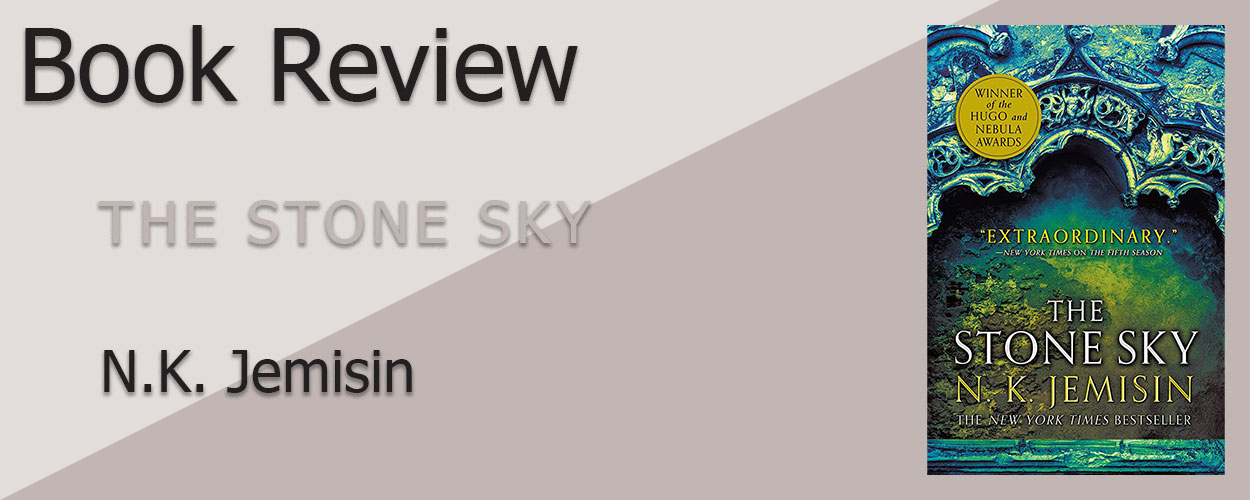

4.5 stars; I really liked it
This is the final book of N.K. Jemisin’s Broken Earth trilogy. Everything is set up so nicely for this book that I can’t wait to see what happens. Castrima needs to flee, and Essun has just used the obelisk gate for the first time, and Nassun has just killed her father in self defence after discovering her own abilities with the obelisks. I couldn’t wait to finish this series!
Read: May 22 – May 27, 2023
Genre: Fantasy, Science Fiction
Audience: Adult
Book contains: violence, implicit sex, foul language, major character death
Purchase a copy from Amazon.ca
After using the obelisk gate to obliterate the invaders, Essun falls into a coma. Meanwhile, Castrima-under can no longer be used, so the comm journeys north to the now empty city of Rennanis, and Essun is taken with them. She only has a few months left before she must catch the moon to stop the Seasons, once and for all, but until then, she’s limited in what she can do, lest she turn to stone like Alabaster.
After killing her father, Nassun knows she must flee Found Moon. She and Schaffa set out, planning to travel to the other side of the world.
Beginning almost immediately after the second book, The Stone Sky is told again from three perspectives, and there are no interludes, as it becomes clear that Hoa is the one telling the story to Essun—it even becomes clear why he is telling the story to her by the end. The end goal is to stop the Seasons by catching the moon and appeasing Father Earth’s rage, but to understand why humankind should be forgiven, we must first understand what they did that was so unforgivable.
Hoa’s past was the part of this book I loved the most, as it dives into the far past—forty thousand years before the book’s “present day” events—back to when he was still (relatively) human. He recounts the days leading up to the event that would change everything, labelling them Five, Four, Three, Two, One, and Zero before the first ever launch of the obelisk gate. These sections really dive into the past and creation of the stone eaters, showing the why as well as the how, and I was so impressed every time a new layer of depth was peeled back.
Nassun and Schaffa are travelling, together, as I mentioned, after leaving Found Moon. Their journey will take them to Corepoint, where the stone eaters took Alabaster after the destruction of Meov, which lies on the other side of the world. She cannot use the Onyx like her mother can, but she plans to use the obelisk gate for her own purposes, and Schaffa will love and support her in all of her endeavours, like the father she wished she had. It’s very well done how their parent-child relationship differs so much from Nassun’s relationships with her biological parents. Exploring further beyond the second book, you can really understand Nassun’s feelings on the matter, even as you switch back to Essun’s perspective (especially after she finds out that Nassun is with Schaffa).
Now that Essun has used the obelisk gate her magic is settling into a firm lattice like it did with Alabaster, and like him, she is slowly turning to stone and allowing herself to be consumed by a stone eater. (It’s hinted at in the second book, but I was quite proud of myself for figuring out ahead of time what the purpose of stone eaters eating “stoned” orogenes truly is.) Because of this, though, she is limited in what she can do. If she’s to survive long enough to open the gate again, she can’t use her orogeny or magic. She feels a major drop in self-esteem and usefulness from this.
She does, however, finally figure things out with Lerna, which I’m happy about. They seemed to be dancing around each other for the first two books (mostly in the second one), and they finally get together.
I’m really getting used to N.K. Jemisin’s unique writing style—so much so that I also want to check out her other series, The Inheritance Trilogy, starting with The Hundred Thousand Kingdoms. It seems she’s even more famous for this series than The Broken Earth, but I’ll probably wait a while before buying those books, since my shelf is still quite full and I’m in no rush.
The story is told by Hoa to Essun, which is even clearer now and includes little comments that he makes about what he’s telling (that he didn’t make in books 1 or 2). I admit I was confused about why he needed to tell Essun about these events since she was there to live them, but when the explanation comes, it’s so clever that I actually laughed out loud. It’s hinted at so subtly throughout the book, and when it’s finally revealed, it’s like everything clicks into place.
This was a wonderful conclusion to the series. It wrapped up all the loose ends, and while I’m curious about what’s going to happen to this world and the characters now that the story is done, nothing more needs to be said. There was even less sexual content in this book compared to the others—almost all implicit as well—though some descriptions of gore or violence may be triggering to some readers. Read with caution. Still, I massively enjoyed this book, and the series as a whole.
The Broken Earth Trilogy Book 1: The Fifth Season by N.K. Jemisin
The Broken Earth Trilogy Book 2: The Obelisk Gate by N.K. Jemisin
American Gods by Neil Gaiman
Dune Book 1: Dune by Frank Herbert
Tigerpetal Press is a small book press dedicated to publishing local authors and poets.